A Simultaneous Usage Ratio Based on Occupant Behavior: A Case Study of Intermittent Heating in an Apartment Building in Japan
Abstract
1. Introduction
2. Materials and Methods
2.1. Definition of Simultaneous Usage Ratio
2.2. Overview of a Case Study Building
2.3. Data Collection
3. Results and Analysis
3.1. Classification of Household Composition
3.2. Heating Load Characteristics
3.2.1. Each Dwelling Unit
3.2.2. Each Household Composition
3.2.3. Simultaneous Usage Ratio
3.3. Curve of Simultaneous Usage Ratio
3.3.1. Method of Creating
- Step 1.
- Use Equation (1) to calculate the simultaneous usage ratio for nCi combinations, which mean the total number of combinations of i dwelling units sampled from n dwelling units.
- Step 2.
- Plot the average value of this calculated ratio for nCi combinations as the ratio for i dwelling units.
- Step 1.
- Repeat the above calculations for i = 2 to n dwelling units.
3.3.2. Examination the Number of Combinations for Sampling
3.4. Evaluation of the Simultaneous Usage Ratio
3.5. Case Study of the Simultaneous Usage Ratio
4. Discussion
5. Conclusions
- An analysis of the heating load characteristics for each dwelling unit showed that the design value was 218 MJ/m2/year. In contrast, the mean measured value for all dwelling units was 105 MJ/m2/year, indicating that the design had exceeded the actual load. Furthermore, upon analyzing the heating load characteristics of each household composition, it was clarified that the heating peak load and appearance percentage of peak varied significantly depending on the household composition.
- A method for creating the curve of the simultaneous usage ratio was suggested, and it was confirmed that random sampling using c = 100 combinations had sufficient precision to avoid a combinatorial explosion. It was also found that the simultaneous usage ratio was 53.6% and generally stabilized when the number of dwelling units exceeded 30 based on the curve of the ratio created for 204 dwelling units.
- It was revealed that the simultaneous usage ratio tended to increase within the range of approximately 50 to 70% over time and through the analysis of the influence of changes in household composition on the ratio.
Author Contributions
Funding
Data Availability Statement
Acknowledgments
Conflicts of Interest
References
- Ministry of Economy, Trade and Industry. The Sixth Strategic Energy Plan. 21 October 2021. Available online: https://www.enecho.meti.go.jp/category/others/basic_plan/pdf/strategic_energy_plan.pdf (accessed on 15 May 2024). (In Japanese).
- Kim, H.; Park, K.S.; Cho, S.; Song, Y.H. A Study on Utility of Retrofit that Minimizes the Replacement of Heat-Source System in Large Offices. Energies 2019, 12, 4309. [Google Scholar] [CrossRef]
- Wang, Y.H.; Zou, Z.H.; Lu, K.; Li, Q.; Hu, P.F.; Wang, D. Modeling for on-line monitoring of carbon burnout coefficient in boiler under partial load. Energy 2024, 288, 129859. [Google Scholar] [CrossRef]
- Wu, C.L.; Li, X.F.; Wang, Z.C.; Xu, Z.W.; Xu, C.; Yang, Y.X. Optimizing the selection and combined operation of multiple air-source heat pumps for sustainable heating systems. Energy Build. 2024, 310, 114052. [Google Scholar] [CrossRef]
- Nair, G.; Gustavsson, L.; Mahapatra, K. Factors influencing energy efficiency investments in existing Swedish residential buildings. Energy Policy 2010, 38, 2956–2963. [Google Scholar] [CrossRef]
- Suh, D.; Chang, S. A Heuristic Rule-Based Passive Design Decision Model for Reducing Heating Energy Consumption of Korean Apartment Buildings. Energies 2014, 7, 6897–6929. [Google Scholar] [CrossRef]
- Ling, J.H.; Li, Q.; Xing, J.C. The influence of apartment location on household space heating consumption in multi-apartment buildings. Energy Build. 2015, 103, 185–197. [Google Scholar] [CrossRef]
- Danielski, I.; Nair, G.; Joelsson, A.; Fröling, M. Heated atrium in multi-storey apartment buildings, a design with potential to enhance energy efficiency and to facilitate social interactions. Build. Environ. 2016, 106, 352–364. [Google Scholar] [CrossRef]
- Belazi, W.; Ouldboukhitine, S.E.; Chateauneuf, A.; Bouchair, A. Thermal modeling of the occupied multi-zone buildings taking into account the uncertainties of occupant behavior. C-CORE Publ. 2022, 33, 101978. [Google Scholar] [CrossRef]
- Fajilla, G.; Borri, E.; De Simone, M.; Cabeza, L.F.; Braganca, L. Effect of Climate Change and Occupant Behaviour on the Environmental Impact of the Heating and Cooling Systems of a Real Apartment. A Parametric Study through Life Cycle Assessment. Energies 2021, 14, 8356. [Google Scholar] [CrossRef]
- Qi, X.Y.; Zhang, Y.; Jin, Z.E. Building Energy Efficiency for Indoor Heating Temperature Set-Point: Mechanism and Case Study of Mid-Rise Apartment. Buildings 2023, 13, 1189. [Google Scholar] [CrossRef]
- Seo, R.S.; Jung, G.J.; Rhee, K.N. Impact of green retrofits on heating energy consumption of apartment buildings based on nationwide energy database in South Korea. Energy Build. 2023, 292, 113142. [Google Scholar] [CrossRef]
- Andersen, S.; Andersen, R.K.; Olesen, B.W. Influence of heat cost allocation on occupants’ control of indoor environment in 56 apartments: Studied with measurements, interviews and questionnaires. Build. Environ. 2016, 101, 1–8. [Google Scholar] [CrossRef]
- Michnikowski, P. Allocation of heating costs with consideration to energy transfer from adjacent apartments. Energy Build. 2017, 139, 224–231. [Google Scholar] [CrossRef]
- Siggelsten, S. Heat cost allocation in energy efficient multi-apartment buildings. Cogent Eng. 2018, 5, 1438728. [Google Scholar] [CrossRef]
- Santin, O.G.; Itard, L.; Visscher, H. The effect of occupancy and building characteristics on energy use for space and water heating in Dutch residential stock. Energy Build. 2009, 41, 1223–1232. [Google Scholar] [CrossRef]
- Kyro, R.; Heinonen, J.; Saynajoki, A.; Junnila, S. Occupants have little influence on the overall energy consumption in district heated apartment buildings. Energy Build. 2011, 43, 3484–3490. [Google Scholar] [CrossRef]
- Kim, M.J.; Cho, M.E.; Kim, J.T. Energy use of households in apartment complexes with different service life. Energy Build. 2013, 66, 591–598. [Google Scholar] [CrossRef]
- Engvall, K.; Lampa, E.; Levin, P.; Wickman, P.; Ofverholmd, E. Interaction between building design, management, household and individual factors in relation to energy use for space heating in apartment buildings. Energy Build. 2014, 81, 457–465. [Google Scholar] [CrossRef]
- Fransson, V.; Bagge, H.; Johansson, D. Impact of variations in residential use of household electricity on the energy and power demand for space heating—Variations from measurements in 1000 apartments. Appl. Energy 2019, 254, 113599. [Google Scholar] [CrossRef]
- Haines, V.; Kyriakopoulou, K.; Lawton, C. End user engagement with domestic hot water heating systems: Design implications for future thermal storage technologies. Energy Res. Soc. Sci. 2019, 49, 74–81. [Google Scholar] [CrossRef]
- Moeller, S.; Weber, I.; Schröder, F.; Bauer, A.; Harter, H. Apartment related energy performance gap—How to address internal heat transfers in multi-apartment buildings. Energy Build. 2020, 215, 109887. [Google Scholar] [CrossRef]
- Lee, J.Y.; Yim, T. Energy and flow demand analysis of domestic hot water in an apartment complex using a smart meter. Energy 2021, 229, 120678. [Google Scholar] [CrossRef]
- Tran, L.N.; Gao, W.J.; Novianto, D.; Ushifusa, Y.; Fukuda, H. Relationships between household characteristics and electricity end-use in Japanese residential apartments. Sustain. Cities Soc. 2021, 64, 102534. [Google Scholar] [CrossRef]
- Jang, H.J.; Kang, J. A stochastic model of integrating occupant behaviour into energy simulation with respect to actual energy consumption in high-rise apartment buildings. Energy Build. 2016, 121, 205–216. [Google Scholar] [CrossRef]
- Kim, D.D.; Suh, H.S. Heating and cooling energy consumption prediction model for high-rise apartment buildings considering design parameters. Energy Sustain. Dev. 2021, 61, 1–14. [Google Scholar] [CrossRef]
- Weissmann, C.; Hong, T.; Graubner, C.-A. Analysis of heating load diversity in German residential districts and implications for the application in district heating systems. Energy Build. 2017, 139, 302–313. [Google Scholar] [CrossRef]
- An, J.J.; Yan, D.; Hong, T.Z. Clustering and statistical analyses of air-conditioning intensity and use patterns in residential buildings. Energy Build. 2018, 174, 214–227. [Google Scholar] [CrossRef]
- Wang, Y.; Cooper, E.; Tahmasebi, F.; Chalabi, Z.; Stamp, S.; Burman, E.; Mumovic, D. A multilevel window state model based on outdoor environmental conditions that captures behavioural variation at room and apartment levels. Energy Build. 2022, 277, 112562. [Google Scholar] [CrossRef]
- Vogiatzi, C.; Gemenetzi, G.; Massou, L.; Poulopoulos, S.; Papaefthimiou, S.; Zervas, E. Energy use and saving in residential sector and occupant behavior: A case study in Athens. Energy Build. 2018, 181, 1–9. [Google Scholar] [CrossRef]
- He, Y.L.; Chen, Y.X.; Chen, Z.H.; Deng, Z.; Yuan, Y. Impacts of Occupant Behavior on Building Energy Consumption and Energy Savings Analysis of Upgrading ASHRAE 90.1 Energy Efficiency Standards. Buildings 2022, 12, 1108. [Google Scholar] [CrossRef]
- Xu, B.P.; Chen, Z.; Wang, X.; Jiang, P.H. Field tests to examine energy saving effects of occupants’ thermostatic radiator valves (TRVs) regulating behavior in district heating systems. Sci. Technol. Built Environ. 2023, 29, 96–105. [Google Scholar] [CrossRef]
- Uddin, M.N.; Chi, H.L.; Wei, H.H.; Lee, M.; Ni, M. Influence of interior layouts on occupant energy-saving behaviour in buildings: An integrated approach using Agent-Based Modelling, System Dynamics and Building Information Modelling. Renew. Sustain. Energy Rev. 2022, 161, 112382. [Google Scholar] [CrossRef]
- Chen, S.; Zhang, G.M.; Xia, X.B.; Chen, Y.X.; Setunge, S.; Shi, L. The impacts of occupant behavior on building energy consumption: A review. Sustain. Energy Technol. 2021, 45, 101212. [Google Scholar] [CrossRef]
- Frederiks, E.R.; Stennerl, K.; Hobman, E.V. Household energy use: Applying behavioural economics to understand consumer decision-making and behaviour. Renew. Sustain. Energy Rev. 2015, 41, 1385–1394. [Google Scholar] [CrossRef]
- Delzendeh, E.; Wu, S.; Lee, A.; Zhou, Y. The impact of occupants’ behaviours on building energy analysis: A research review. Renew. Sustain. Energy Rev. 2017, 80, 1061–1071. [Google Scholar] [CrossRef]
- Bouktif, S.; Ouni, A.; Lazarova-Molnar, S. Towards a Rigorous Consideration of Occupant Behaviours of Residential Households for Effective Electrical Energy Savings: An Overview. Energies 2022, 15, 1741. [Google Scholar] [CrossRef]
- Khanam, T.; Reiner, D.M. Evaluating gaps in knowledge, willingness and heating performance in individual preferences on household energy and climate policy: Evidence from the UK. Renew. Sustain. Energy Rev. 2022, 160, 112229. [Google Scholar] [CrossRef]
- Xu, X.X.; Yu, H.; Sun, Q.W.; Tam, V.W.Y. A critical review of occupant energy consumption behavior in buildings: How we got here, where we are, and where we are headed. Renew. Sustain. Energy Rev. 2023, 182, 113396. [Google Scholar] [CrossRef]
- Zhang, Z.C.; Yao, J.; Zheng, R.Y. Multi-Objective Optimization of Building Energy Saving Based on the Randomness of Energy-Related Occupant Behavior. Sustainability 2024, 16, 1935. [Google Scholar] [CrossRef]
- 41. ISO 18523-1:2016; Energy Performance of Buildings—Schedule and Condition of Building, Zone and Space Usage for Energy Calculation—Part 1: Non-Residential Buildings. ISO: Geneva, Switzerland, 2016.
- Bauer, A.; Möller, S.; Gill, B.; Schröder, F. When energy efficiency goes out the window: How highly insulated buildings contribute to energy-intensive ventilation practices in Germany. Energy Res. Soc. Sci. 2021, 72, 101888. [Google Scholar] [CrossRef]
- Ascione, F.; De Masi, R.F.; Festa, V.; Gigante, A.; Ruggiero, S.; Vanoli, G.P. Thermal and energy performance of a nearly zero-energy building in Mediterranean climate: The gap between designed and monitored loads of space heating and cooling systems. Energy Source Part A 2022, 44, 732–747. [Google Scholar] [CrossRef]
- Zare, N.; Saryazdi, S.M.E.; Bahman, A.M.; Shafaat, A.; Sartipipour, M. Investigation of heating energy performance gap (EPG) in design and operation stages of residential buildings. Energy Build. 2023, 301, 113747. [Google Scholar] [CrossRef]
- Staveckis, A.; Zemitis, J. Impact of the Limited Heat Source Capacity on Indoor Temperature and Energy Consumption in Serial nZEB Residential Buildings across the Baltic Region. Energies 2023, 16, 5924. [Google Scholar] [CrossRef]
- Guerra-Santin, O.; Herrera, N.R.; Cuerda, E.; Keyson, D. Mixed methods approach to determine occupants’ behaviour—Analysis of two case studies. Energy Build. 2016, 130, 546–566. [Google Scholar] [CrossRef]
- Yousefi, F.; Gholipour, Y.; Yan, W. A study of the impact of occupant behaviors on energy performance of building envelopes using occupants’ data. Energy Build. 2017, 148, 182–198. [Google Scholar] [CrossRef]
- National Institute of Population and Social Security Research. Estimated Future Number of Households in Japan. 12 April 2024. Available online: https://www.ipss.go.jp/pp-ajsetai/j/HPRJ2024/t-page.asp (accessed on 15 May 2024). (In Japanese).
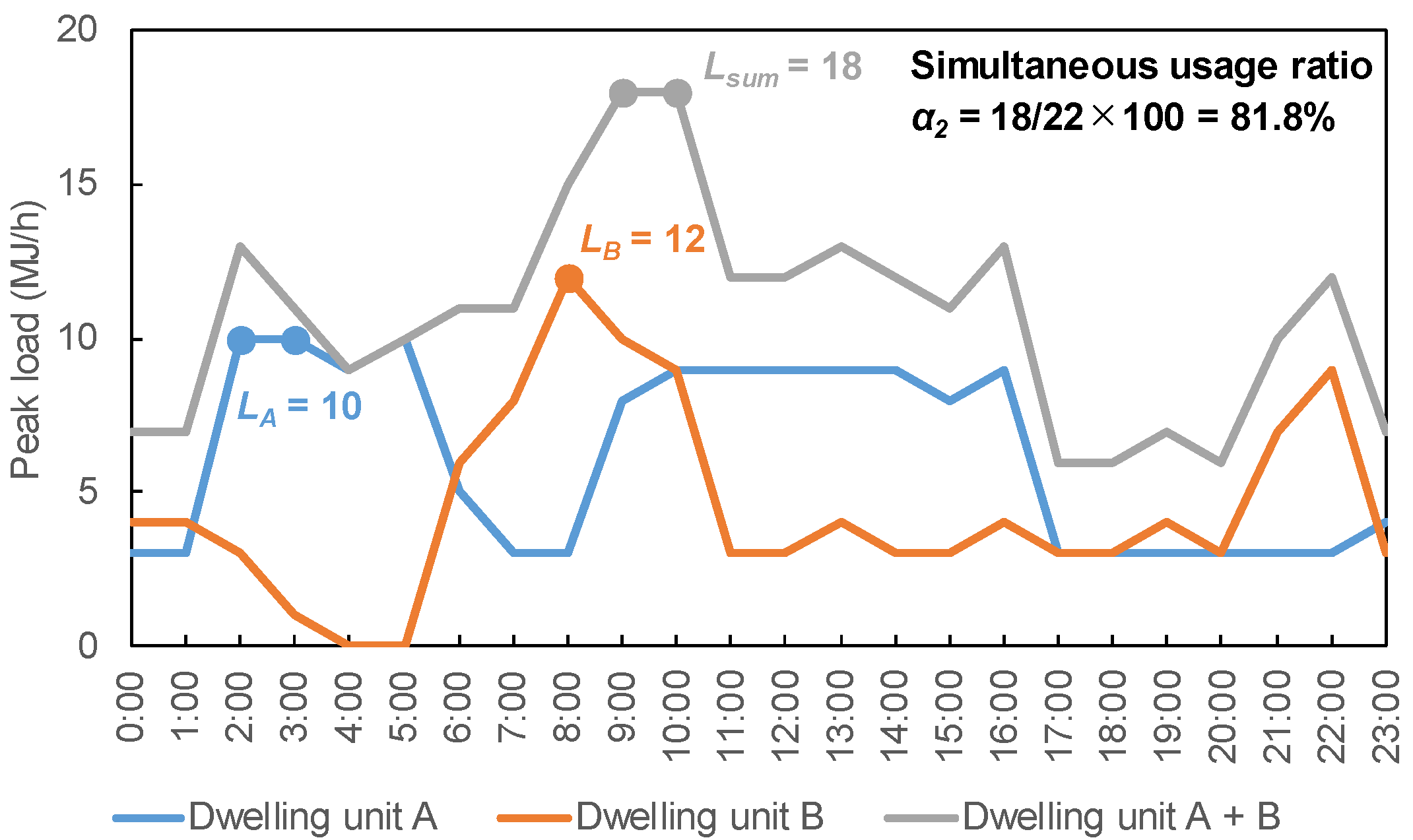

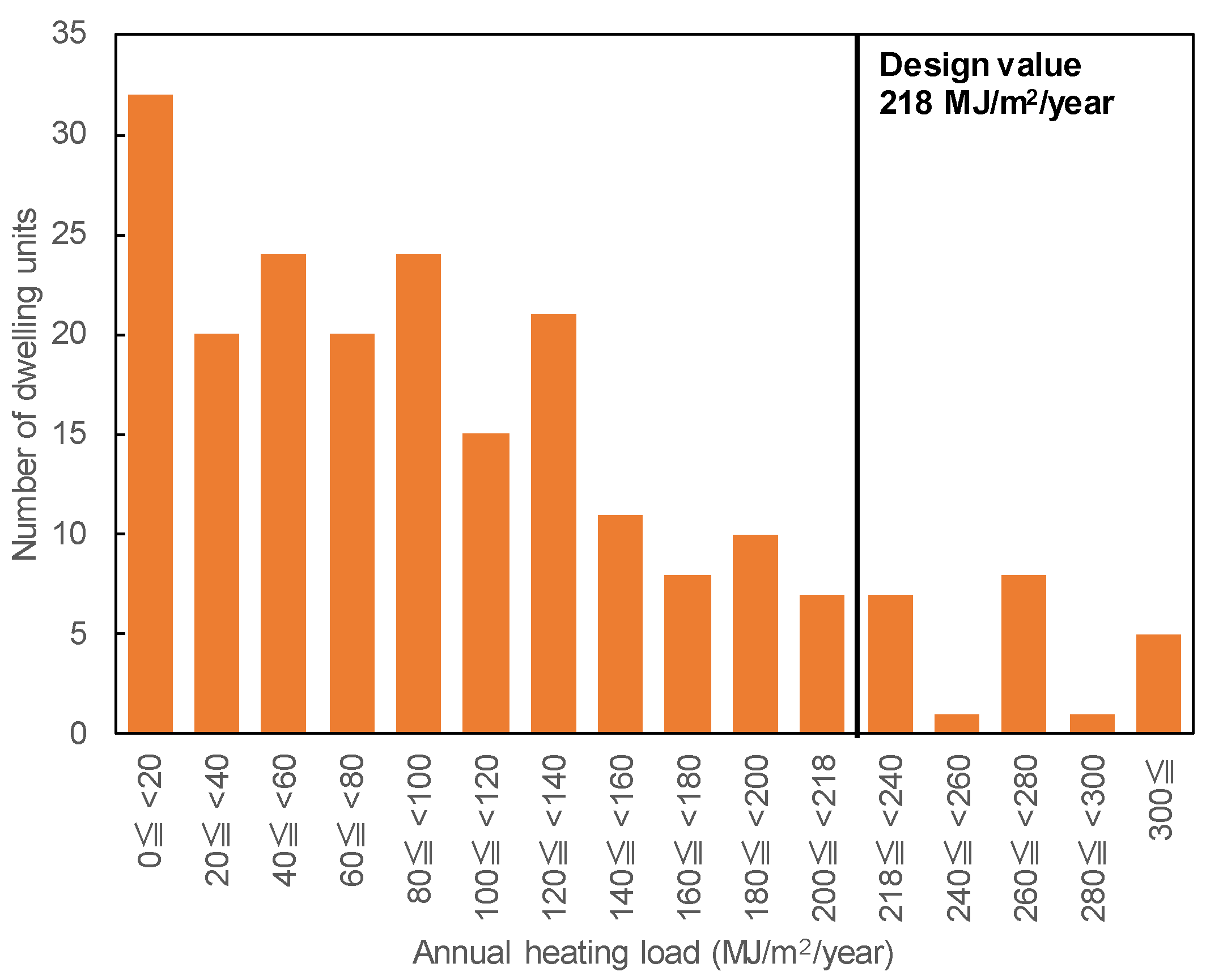
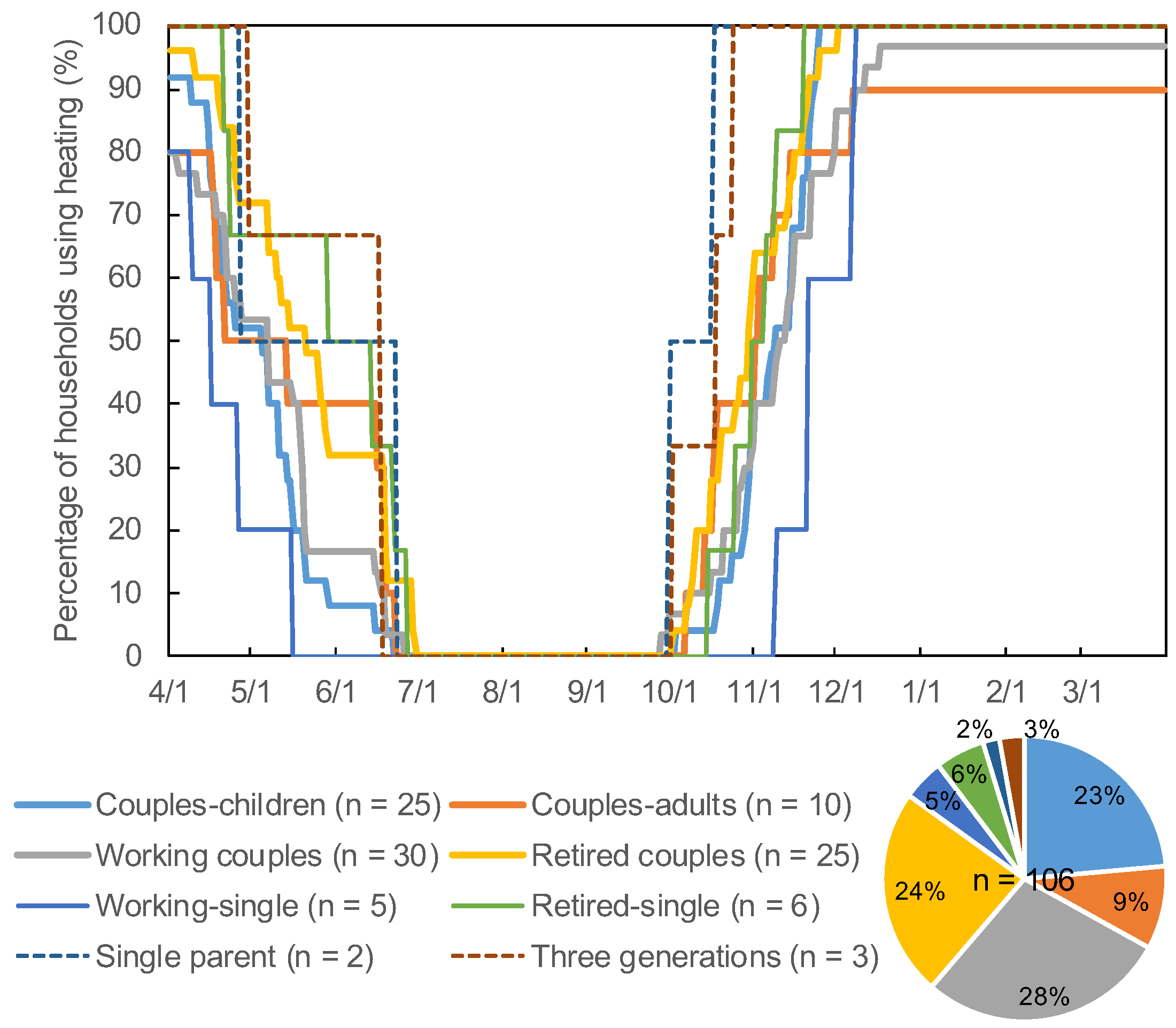
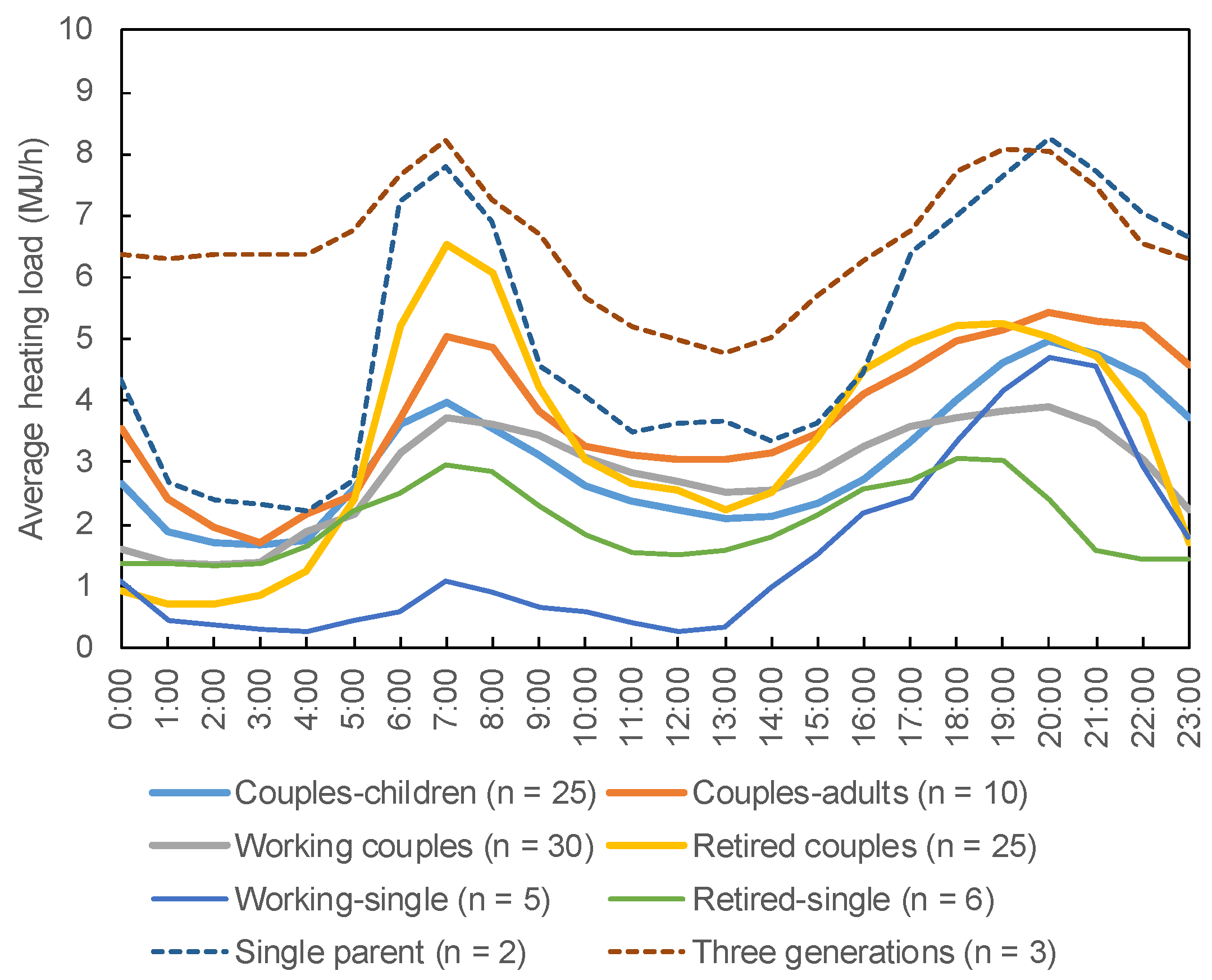
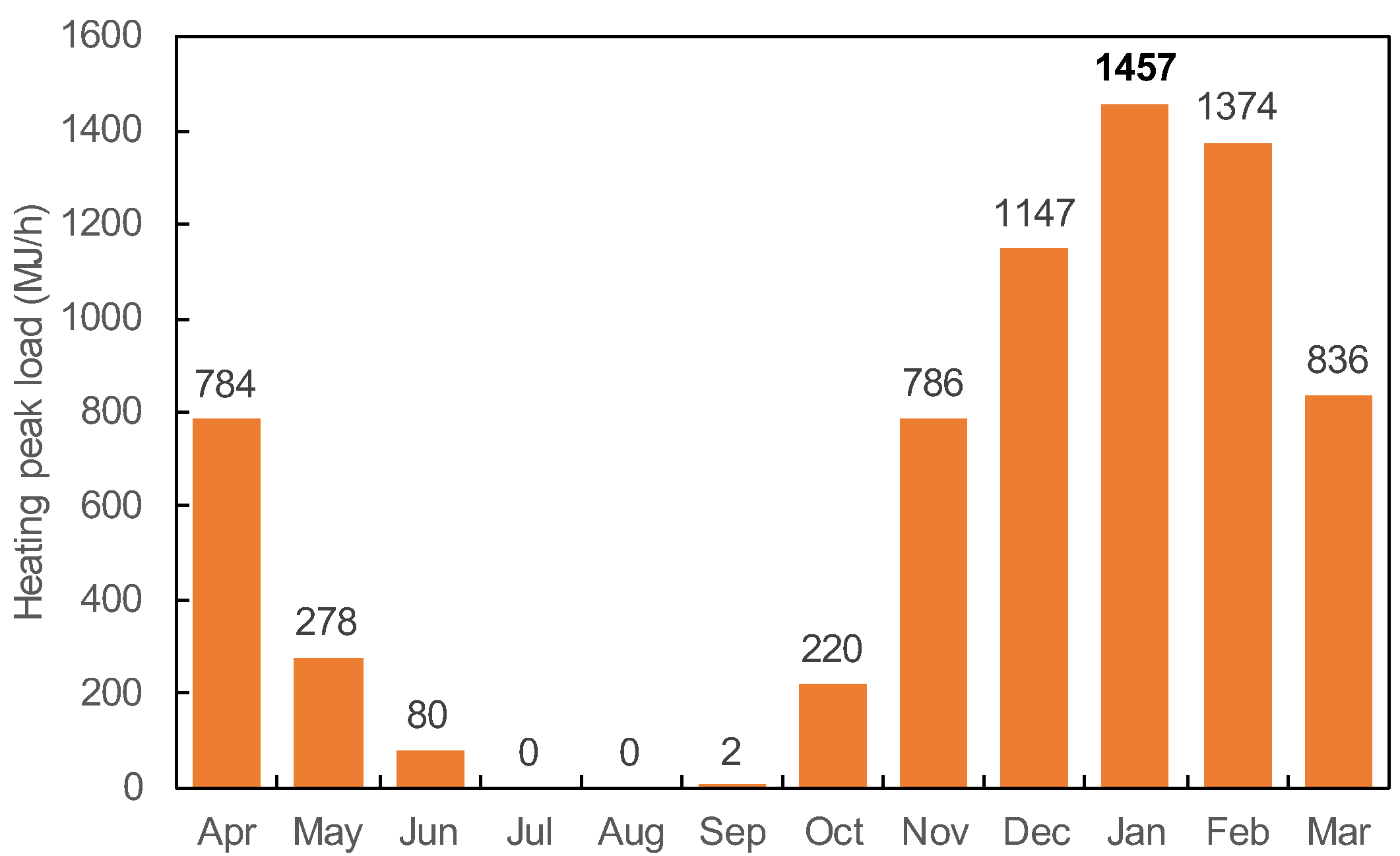
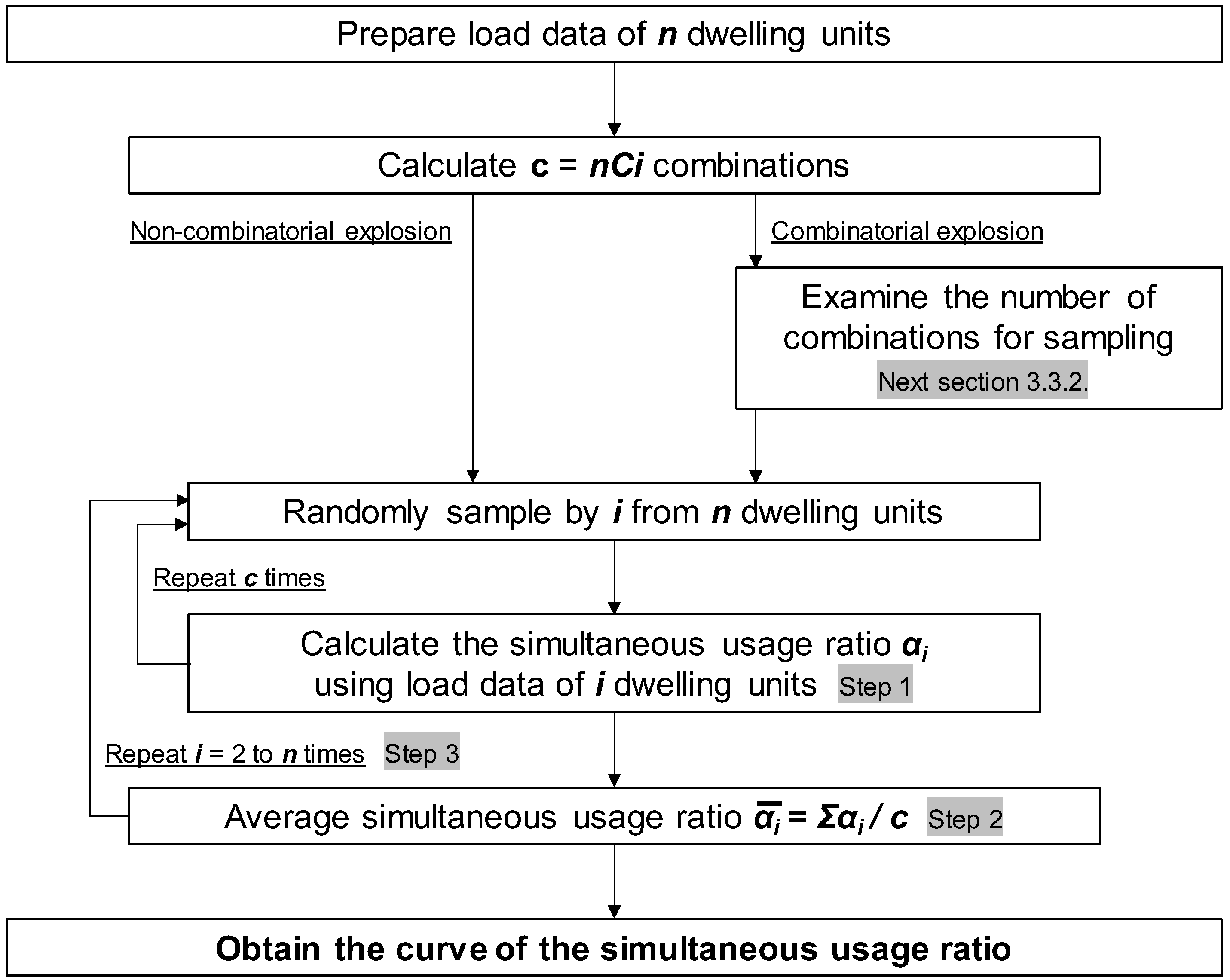

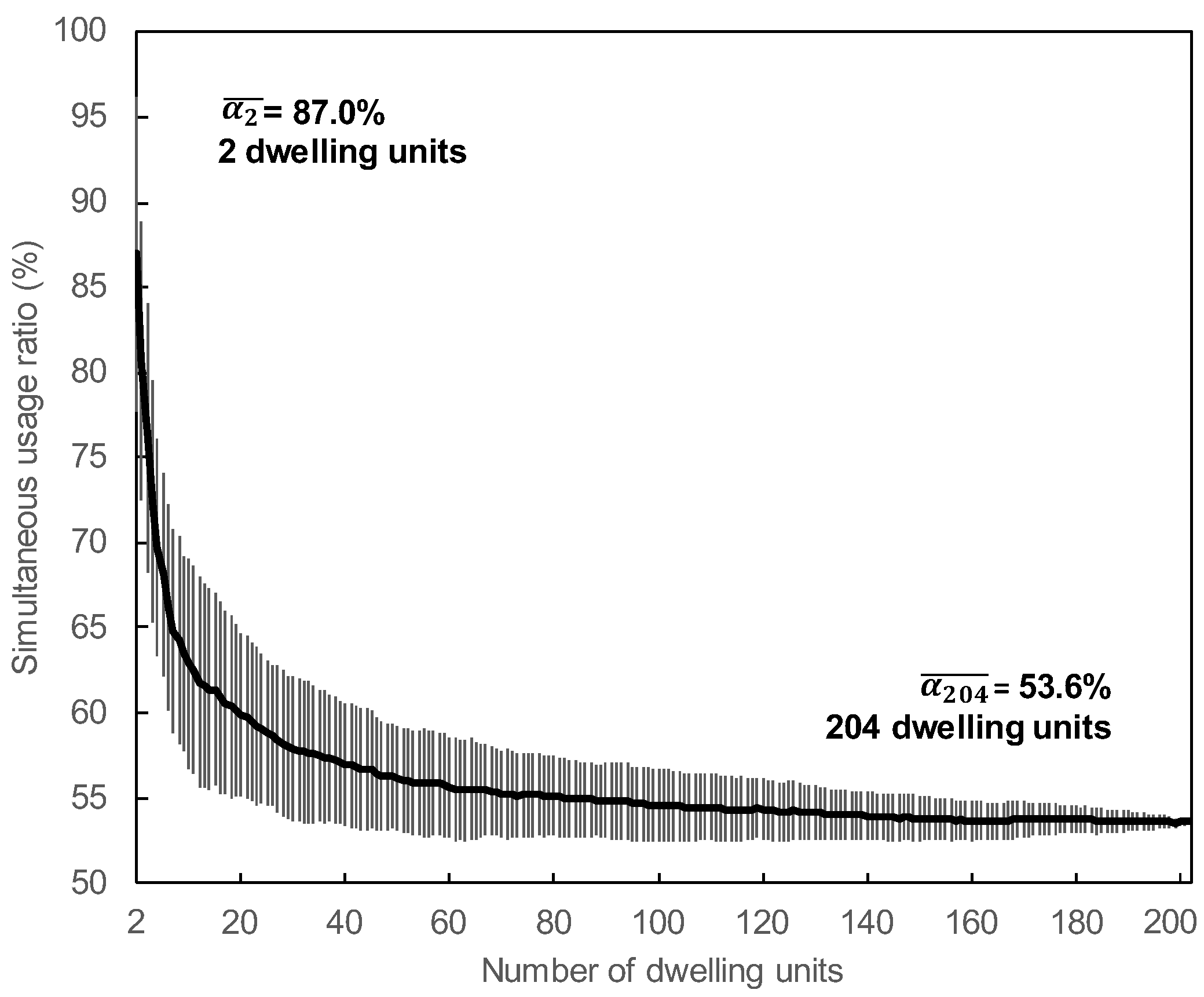
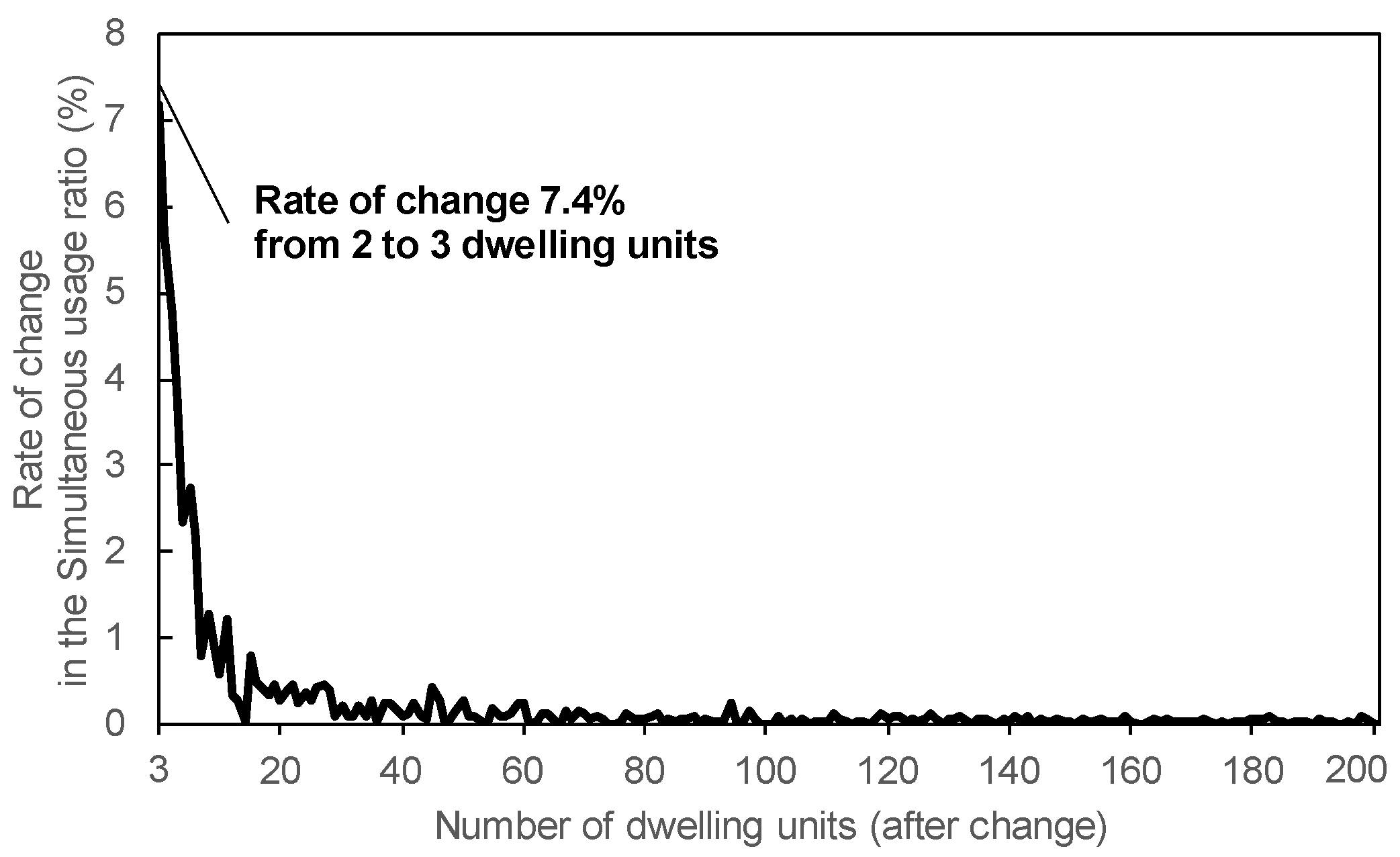
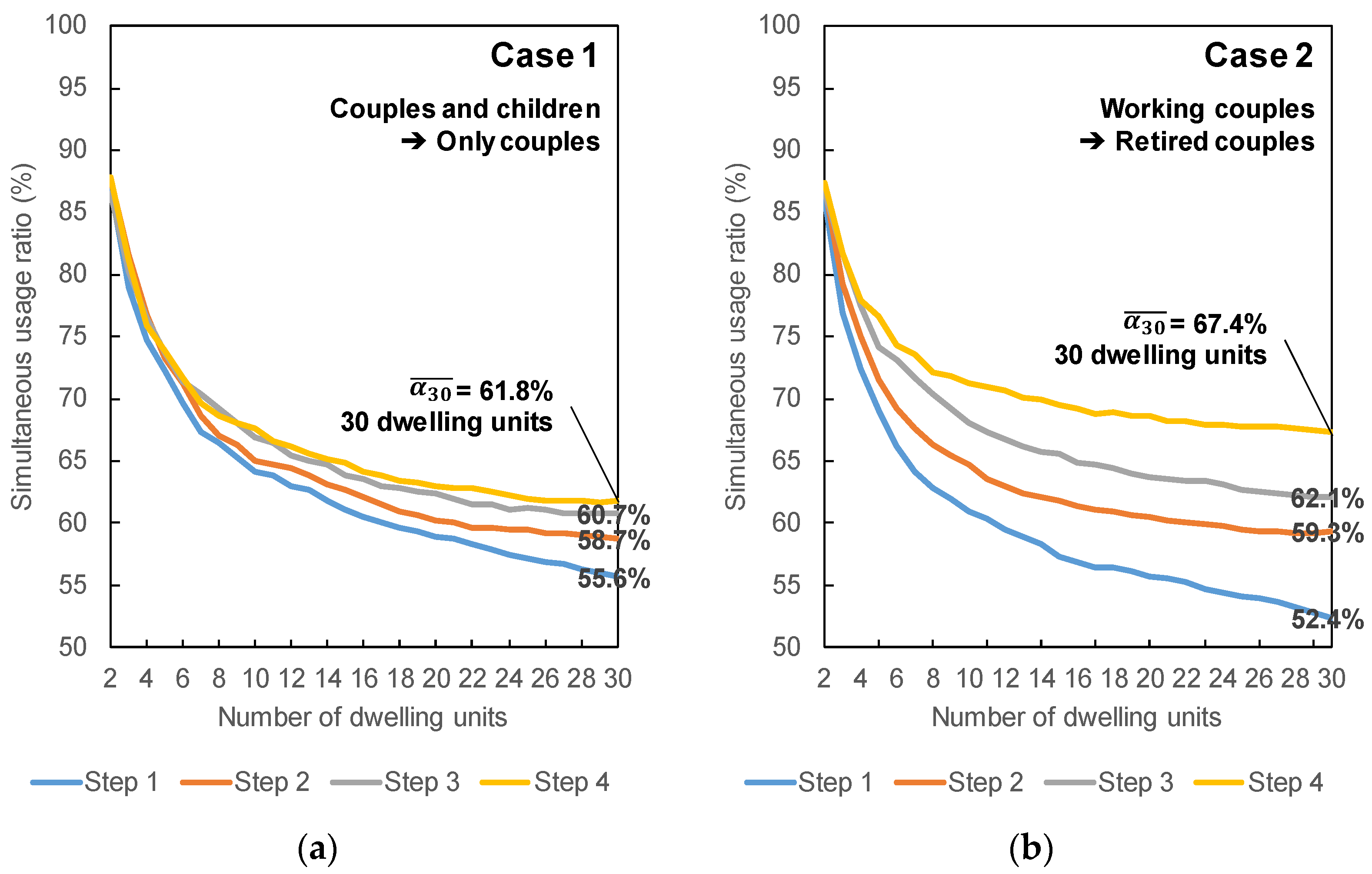
| Household Composition | Lifestyle Schedule | ||
|---|---|---|---|
| Number of people | Age | Occupation | A day in the life during winter |
| Answer is number of people living together | Answer in tens of years | Answer is chosen from working outside the home, working at home, full-time housewife/househusband, university student, high school student, junior high school student, elementary school student, preschooler, and unemployed | Answer is hourly times for going out, sleeping, eating, bathing, and using heating |
| Major Classification | Minor Classification | Definition |
|---|---|---|
| Couples and children | Couple–children (n = 25) | A married couple and children who are students or preschoolers |
| Couple–adults (n = 10) | A married couple and working children | |
| Only couples | Working couples (n = 30) | At least one person is employed |
| Retired couples (n = 25) | Both members of the couple are retired | |
| Single | Working–single (n = 5) | One person is employed |
| Retired–single (n = 6) | One person is retired | |
| Other | Single parent (n = 2) | A single parent and children who are students or preschoolers |
| Three generations (n = 3) | Three generations of grandparents, parents, and children |
| Combinations | c = 10 | c = 50 | c = 100 | c = 200 | c = 500 |
|---|---|---|---|---|---|
| (2 dwelling units) % | 87.428 | 86.281 | 86.694 | 85.738 | 86.024 |
| (200 dwelling units) % | 53.517 | 53.668 | 53.639 | 53.615 | 53.606 |
| RMSE (2–204 dwelling units) | 0.804 | 0.400 | 0.206 | 0.192 | - |
| Case | Classification | Step 1 | Step 2 | Step 3 | Step 4 |
|---|---|---|---|---|---|
| Case 1 | Couples and children | n = 30 | n = 20 | n = 10 | n = 0 |
| Only couples | n = 0 | n = 10 | n = 20 | n = 30 | |
| Case 2 | Working couples | n = 29 | n = 20 | n = 10 | n = 6 |
| Retired couples | n = 1 | n = 10 | n = 20 | n = 24 |
Disclaimer/Publisher’s Note: The statements, opinions and data contained in all publications are solely those of the individual author(s) and contributor(s) and not of MDPI and/or the editor(s). MDPI and/or the editor(s) disclaim responsibility for any injury to people or property resulting from any ideas, methods, instructions or products referred to in the content. |
© 2024 by the authors. Licensee MDPI, Basel, Switzerland. This article is an open access article distributed under the terms and conditions of the Creative Commons Attribution (CC BY) license (https://creativecommons.org/licenses/by/4.0/).
Share and Cite
Kikuta, K.; Abe, Y. A Simultaneous Usage Ratio Based on Occupant Behavior: A Case Study of Intermittent Heating in an Apartment Building in Japan. Buildings 2024, 14, 1518. https://doi.org/10.3390/buildings14061518
Kikuta K, Abe Y. A Simultaneous Usage Ratio Based on Occupant Behavior: A Case Study of Intermittent Heating in an Apartment Building in Japan. Buildings. 2024; 14(6):1518. https://doi.org/10.3390/buildings14061518
Chicago/Turabian StyleKikuta, Koki, and Yuhei Abe. 2024. "A Simultaneous Usage Ratio Based on Occupant Behavior: A Case Study of Intermittent Heating in an Apartment Building in Japan" Buildings 14, no. 6: 1518. https://doi.org/10.3390/buildings14061518
APA StyleKikuta, K., & Abe, Y. (2024). A Simultaneous Usage Ratio Based on Occupant Behavior: A Case Study of Intermittent Heating in an Apartment Building in Japan. Buildings, 14(6), 1518. https://doi.org/10.3390/buildings14061518










